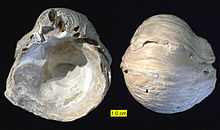Gryphaea
| Gryphaea Temporal range: 235.000–33.900Ma Carnian - Eocene | |
|---|---|
 | |
| Gryphaea sp. from the Cretaceous of Texas; left valve interior and exterior (same specimen). | |
| Scientific classification | |
| Kingdom: | Animalia |
| Phylum: | Mollusca |
| Class: | Bivalvia |
| Order: | Ostreoida |
| Family: | Gryphaeidae |
| Genus: | Gryphaea (Lamarck, 1801) |
Gryphaea, common name Devil's toenails, is a genus of extinct oysters, marine bivalve mollusks in the family Gryphaeidae.
These fossils range from the Jurassic to the Cretaceous periods. They are particularly common in many parts of Britain.
These oysters lived on the sea bed in shallow waters, possibly in large colonies. The complete fossils consist of two articulated valves: a larger gnarly-shaped shell (the "toenail") and a smaller, flattened shell, the "lid". The soft parts of the animal occupied the cavity between the two shells, just like modern oysters. The shells also feature prominent growth bands. The larger, curved shell sat within the mud on the sea floor. These shells are sometimes found in fossil plates along with Turritella, clams, and sometimes sharks' teeth and fossilized fish scales.
A classic location to find these fossils is Redcar, on the northeast coast of England. There used to be a common folk belief that carrying one of these fossils could prevent rheumatism. They are also found in abundance in the state of Kansas in riverbeds and cliffs.
The name "Devil's toenail" is also used for some fossil species of the genus Exogyra, which is in the same family (Gryphaeidae) as Gryphaea.See also
References
External links
| Wikimedia Commons has media related to Gryphaea. |